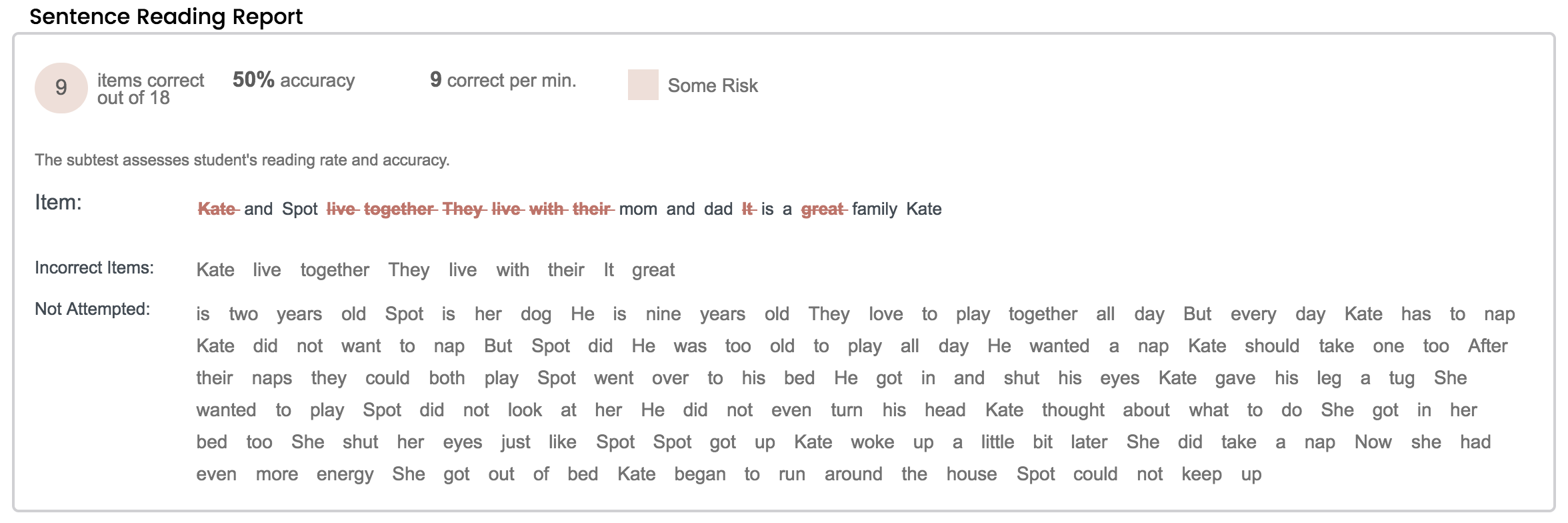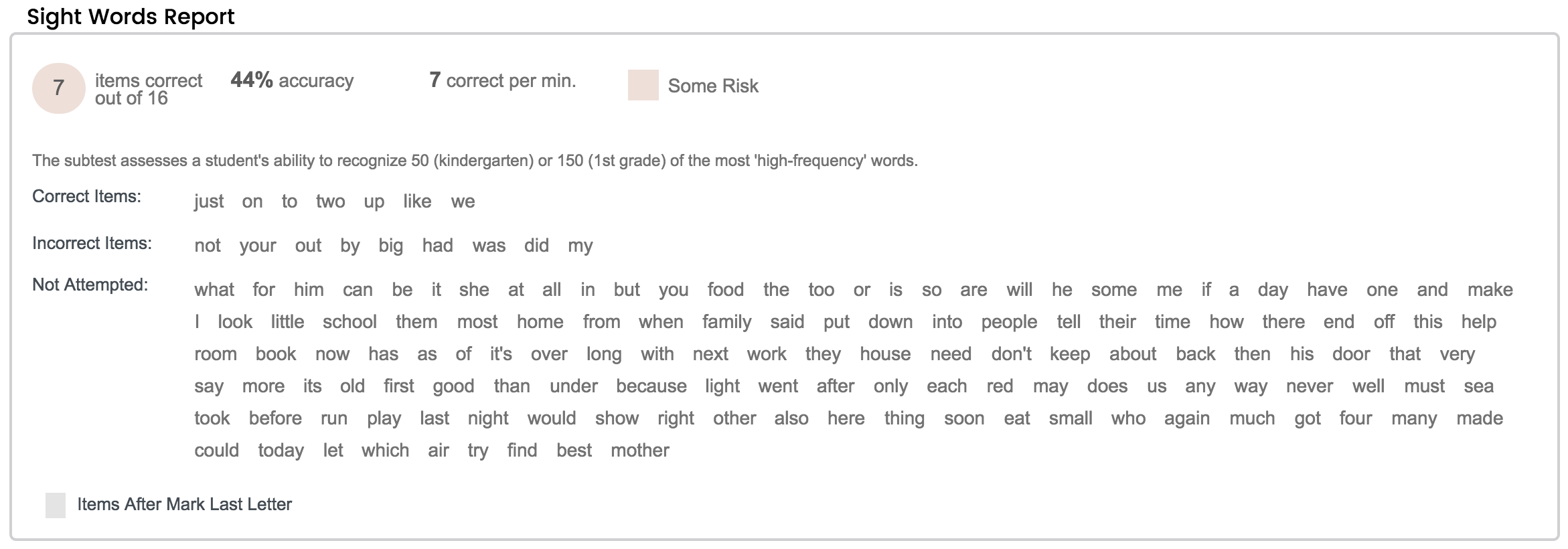How to Select the Right Progress Measures for Reading
Progress monitoring is an important way that teachers can learn whether interventions provided to help students catch up are working. However, in order for progress data to be helpful, the progress assessment must measure the specific skill the student is learning (i.e., the assessment must be valid). Fastbridge has a number of reading progress assessments that can be used alongside interventions.
This blog will provide information about how to select reading progress measures based on the skills included in the intervention.
5 Key Areas of Reading
There are five major components of reading that students must learn, as defined by the National Reading Panel (2000).
-
Phonemic awareness
The ability to recognize, blend, and segment the individual sounds (phonemes) in words.
-
Phonics
The ability to connect specific sounds with letters and combinations of letters in order to form words.
-
Fluency
The ability to read words, sentences, and longer texts automatically and without hesitation.
-
Vocabulary
Knowledge of the meanings of words in printed texts.
-
Comprehension
An understanding of the overall purpose, meaning, and implications from the ideas in texts.
Most of the time, a student’s reading difficulties will fall into one of the above 5 skill areas. For example, the image below shows earlyReading™ scores for a first grader. The teacher noted that the Composite score was 26, which indicates a high risk of reading difficulties.
During a meeting with the first-grade team, a review of the Individual Skills Report showed which items the student got correct and incorrect.




The score profile showed that the student’s phonemic awareness skills were okay, but his phonics and fluency skills were at some or high risk. The Nonsense Words score showed only 30% accuracy in applying phonics skills to decode words. This profile indicates that this student would most likely benefit from phonics intervention.
FastBridge Reading Progress Measures
Fastbridge has assessments for measuring student progress in all areas of reading. The following table lists the 5 components of reading and the FAST™ measures that can be used to monitor student progress in each area.
Note that some of these measures are part of the FastBridge Research Labs, which means they are not yet fully endorsed for instructional decision-making.
| Component |
Progress Measures |
| Phonemic Awareness |
FastBridge earlyReading English™ – Onset Sounds FastBridge earlyReading English™ – Word Blending FastBridge earlyReading English™ – Word Segmenting |
| Phonics |
FastBridge earlyReading English™ – Decodable Words FastBridge earlyReading English™ – Letter Sounds FastBridge earlyReading English™ – Nonsense Words |
| Fluency |
FastBridge earlyReading English™ – Sight Words FastBridge CBMreading English™ |
| Vocabulary |
FastBridge AUTOreading™ – Matching Synonyms (lab) FastBridge AUTOreading™ – Vocabulary (lab) FastBridge AUTOreading™ – Word Morphology (lab) |
| Comprehension |
FastBridge CBMreading English™ FastBridge CBMcomp™ FastBridge COMPefficiency™ (lab) |
Phonemic Awareness Assessments in FastBridge
There are three FastBridge assessments for phonemic awareness. They are all part of the earlyReading™ suite. These three assessments vary in difficulty with Onset Sounds being the easiest and Word Segmenting being more difficult. If a student cannot yet blend or segment the sounds in a word, then it’s best to start with Onset Sounds, which requires the student to identify and say the first sound in a word.
As the student’s skills improve, change the progress measure to Word Blending, followed by Word Segmenting. Once a student reaches the spring Word Segmenting benchmark, it’s time to move on to a different skill and progress assessment.
Phonics
There are three progress assessments for phonics: Decodable Words, Letter Sounds, and Nonsense Words. The most basic of these is Letter Sounds because it measures whether a student can accurately give the correct sound for each letter. There are two ways of measuring a student’s word-level phonics skills: Decodable Words and Nonsense Words and FastBridge recommends using Nonsense Words.
The reason is that it is a more accurate indicator of a student’s ability to match the correct sound with a letter and blend the sounds into a whole word. By using decodable pseudowords that all have short vowels, the student is presented with a task very much like encountering a decodable real word that he or she has not read before.
By comparison, Decodable Words also includes all short vowel words, however, since these are actual words, the student might have learned them before and then not use decoding skills to read them. They may have instead, read them as sight words and thus this will not provide a true indication of the student’s decoding skills when encountering new words.
Fluency
There are two fluency progress assessments: the Sight Words assessment and the CBMreading™ assessment.
Sight Words assessment has two versions. Sight Words – 50 is typically used with kindergarten students. And Sight Words -150 is used with first grade and older students. The words on this assessment are high-frequency words. Some are decodable and some are irregular, non-decodable words. For both word types, the goal is to see if the student can read them automatically.
CBMreading™ assessment. This is the recommended reading progress assessment for grades 1 through 12 because it provides a transparent look at the student’s current oral reading skills. CBMreading™ progress measures are available for grades 1 through 8.
There are 20 different stories for each grade level. High school students working on reading fluency can be monitored using the eighth grade (or lower) passages.
Vocabulary
At this time, all of the vocabulary progress assessments are part of the FastBridge Research Labs. They are available for customer use but should be accompanied by other sources of information about the student’s vocabulary skills when reviewing progress.
AUTOreading™ Vocabulary
The AUTOreading™ Vocabulary assessment is a variety of important words across grade levels and the student selects the meaning for each.
The AUTOreading™ Morphology
The AUTOreading™ Morphology requires the student to match two words with similar meanings based on commonly used word roots and affixes.
The AUTOreading™ Matching Synonyms
The AUTOreading™ Matching Synonyms requires the student to match two words with similar meanings but which do not necessarily have common roots or affixes.
Comprehension
There are three FastBridge assessments that can be used to monitor a student’s progress toward improved reading comprehension.
CBMreading™
The first is CBMreading,™ which also measures fluency. Although CBMreading™ is an oral reading test, it also captures a significant amount of information about a student’s understanding of text (Reschly, Busch, Betts, Deno, & Long, 2009). This information results from the fact that a reader must use the combination of accuracy, speed, and prosody in order to draw meaning from text.
CBMcomp™
For those students for whom recalling the specific details from the text is the intervention focus, the CBMcomp™ assessment can be used. This assessment is an optional extension of CBMreading.™ It involves having the student read the entire passage and then complete two tasks.
First, the student is asked to tell as many details of the story as possible. Next, the teacher asks the student 10 questions about the passage. The CBMcomp™ measure is automatically available when setting up CBMreading for progress monitoring, however, it is not possible to set separate recall and question goals at this time.
COMPefficiency™
The final comprehension progress assessment is also part of FastBridge® Research Labs. Known as COMPefficiency,™ this assessment presents a reading passage to a student one sentence at a time. In between the sentences, the student answers true or false questions about the passage. At the end of the entire passage, the student answers 10 multiple-choice questions.
This format is designed to capture multiple aspects about the student’s understanding of the text, including specific details, general conclusions, and inferences. As with the other Lab measures, COMPefficiency™ should be used alongside another assessment of reading comprehension.
Selecting the Best Measure Using Individual Skills Report
The process for selecting a progress measure involves identifying which specific reading skill the student needs to work on first. In the above example, the student’s overall Composite earlyReading™ score was low. A review of the Individual Skills Report showed that the student’s Word Segmenting (phonemic awareness) skills were okay, but the phonics and fluency skills were all low.
Since phonics skills (i.e., accuracy) are a prerequisite for fluency, for this student the recommended intervention is to teach sound-symbol correspondence and monitor the student’s progress using a phonics assessment. Since the accuracy on Nonsense Words was very low, the teacher decided to use Letter Sounds as the progress measure to accompany the phonics intervention. Once the student reaches the kindergarten benchmark level on Letter Sounds, the teacher will adjust the phonics intervention and then use Nonsense Words as the next progress assessment.
FastBridge has a number of reading progress measures. In order to know which one will be best for a specific student, the student’s current reading skills need to be evaluated. The Individual Skills Report provides a detailed breakdown of the items that the student answered correctly and incorrectly. This information can be used in relation to knowledge about the five major components of reading.
For more information about available FastBridge reading progress measures, visit https://www.illuminateed.com/products/fastbridge/reading-assessment.
References
National Institute of Child Health and Human Development, NIH, DHHS. (2000). Report of the national reading panel: Teaching children to read. Washington, DC: U.S. Government Printing Office.
Reschly, A. L., Busch, T. W., Betts, J., Deno, S. L., & Long, J. D. (2009). Curriculum-based measurement oral reading as an indicator of reading achievement: A meta-analysis of the correlational evidence. Journal of School Psychology, 47, 427-469. doi:10.1016/j.jsp.2009.07.001

